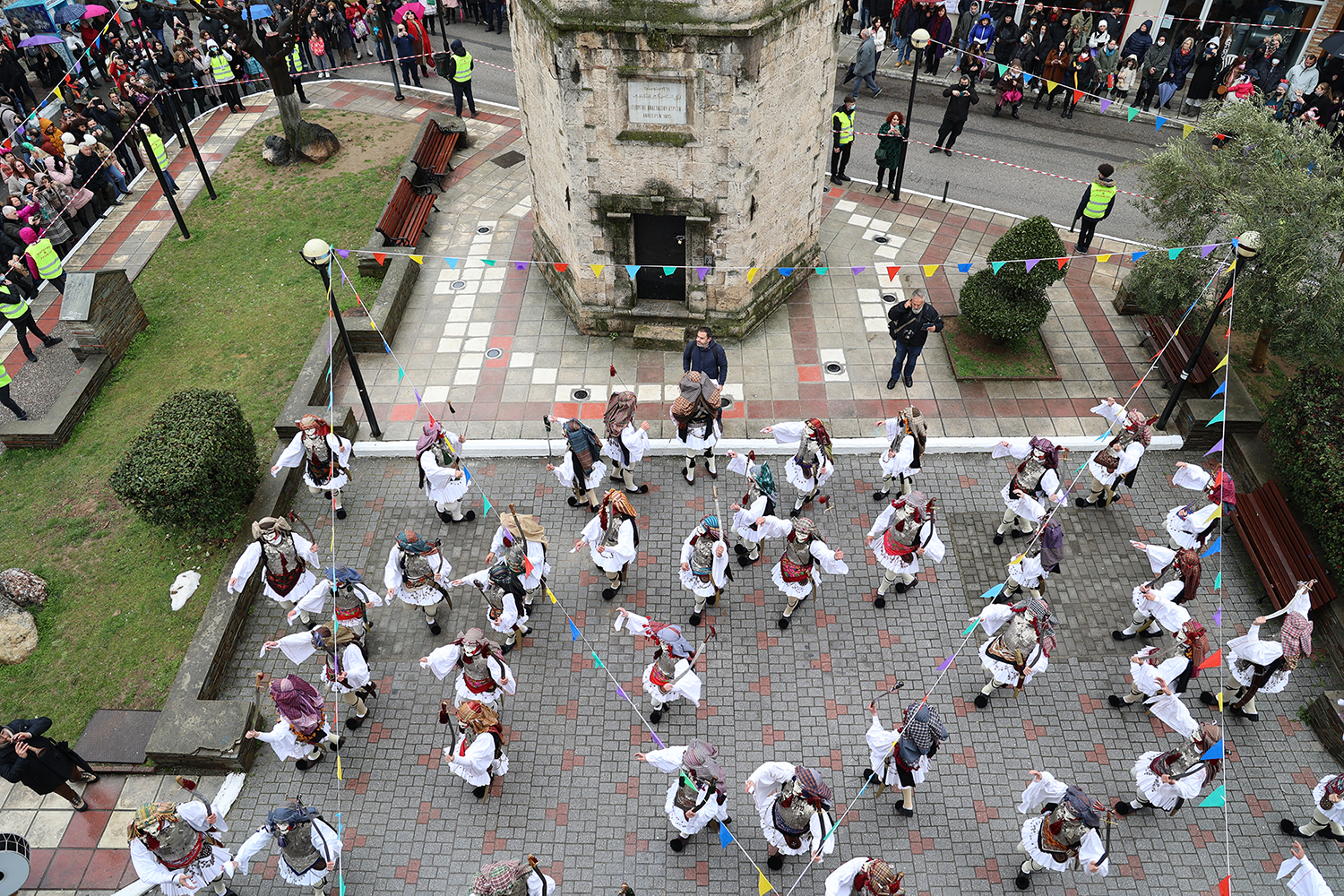Janissaries and Boules
Description
The custom is considered to have its roots in antiquity and the worship of god Dionysus, but mainly in the years of the Ottoman rule as the first evidence of the ritual dates back to 1706, when it took place as a memorial for the child levy of the previous year. The people of Naoussa refused the child levy and killed the sultan’s envoy, so many of them were forced to become “thieves”, i.e. members of illegal mountain troops, resulting in their extermination by the Turks.
“Janissaries and Boules” is essentially a dance event, because the action of the people who participate is a dance action. Without this dance action the reenactment of the custom is not possible. The main elements of the custom are:
- the formation of the troupe, which presupposes the strict acceptance and observance of certain rules of the custom in order to participate in it;
- only young males can participate in the custom;
- the female figure (bride-boula) is always played by a man.
Key message
The custom remains unchanged to this day, incorporating the local tradition, the myths, the legends, the songs and the heroic struggles of Naoussa.
Key activities
- The clothing, the vesture/costumes and the behavior of the performers are characterized by discipline and standardized by traditional rules;
- The traditional musical instruments, the dances and the itinerary are predetermined by the ritual, which is followed unchanged over the years.
Experiential and interactive activities
The participation of relatives and family members of the dancers, during the process of gathering the troupe, in the ceremony of separation from the family and their integration into the herd.
The participation of the audience during the defined route of the troupe in the city, and after the “removal” of the face at the end of the route, the public can participate in the dances with the dancers of the troupe.
Innovative elements
An application has been created for mobile devices so that the user can locate in real time the location of the troupes with the dancers and also read useful information about the custom.
Main features and services that attract public
The uniqueness of the custom in Greece along with the ritual and strictness of its performance.
Key partners and supporters
The Municipality of the Heroic City of Naoussa is the main sponsor of the events during the Carnival, while from time to time public or private bodies may finance some of the events.
Participants, local community and customer segment
Residents of the Municipality of Naoussa and visitors from Greece and abroad.
Communication and dissemination channels
Promotion of the events are made through an advertising campaign of the Municipality of Naoussa in print, radio and television media, social media, etc.
Specific elements and features
Managerial and organizational specifics
The Municipality of Naoussa is the custodian of the custom and organizer of all Carnival events. The Association “Janissaries and Boules Group” is exclusively responsible for the organization and performance of the custom.
Accessibility
Naoussa is accessible via the national road network. Within the urban fabric there are sidewalks, bike paths and parking spaces. Access to all activities is possible for all age groups and people with disabilities.
Liaison with other activities and events of the Black Sea Basin region
There are no associations and connections with other countries for this event.
Image Sources: Photos by the research team
Where
In the city of Naoussa, a mountain city that dates back to the 14th century, located in the Regional Unit of Imathia. In 1955, due to the Holocaust of Naoussa, as it is known the bloody suppression of the revolution against the Ottomans in April 1822, the city was given the title of “Heroic City”. The river Arapitsa that crosses the city has gone down in history for the great sacrifice of the local women, who holding their children, preferred to fall into its waters rather than into the hands of the Turks. Despite its destruction, Naoussa managed to recover and grow in the late 19th century, in the context of the Ottoman Reforms (Tanzimat), with the development of a particularly flourishing textile industry, which continued after the integration of the city to Greece in 1912 to decline in the early 1990s. Although a significant part of the traditional organic urban fabric is maintained, only a small number of the city mansions, typical examples of the traditional Balkan architecture of the end of the 19th and beginning of the 20th century, are preserved. An important element of the cultural heritage of the city is also many industrial buildings dating from the same period. The city park of about 30 acres, which was created in the 1950s, officially joined the European Route of Historic Gardens (ERHG) in 2021.
Schedule
It is an annual event taking place in the period of carnival until the Sunday of Orthodoxy, culminating on the Sunday of Lent and Sunday of Carnival (Tyrinis).
Organizer and contact information
Municipality of the Heroic City of Naoussa
Telephone number: 2332350300,
mail: info@naoussa.gr, culture@naoussa.gr
Association “Janissaries and Boules”
Telephone number: 6979230324,
Arisitidis Tosios, President









